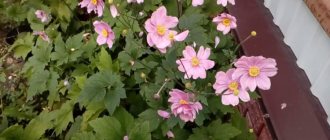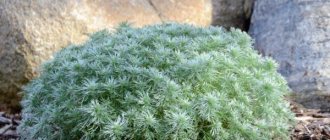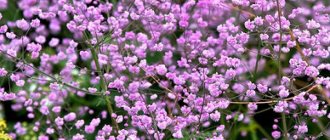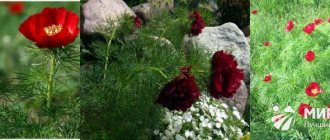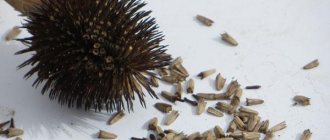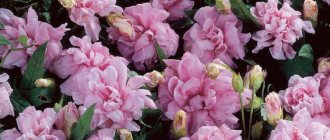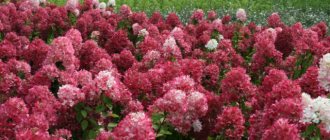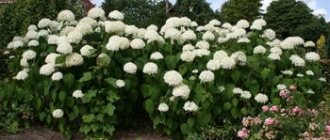The herbaceous perennial mukdenia was named by the Japanese botanist Gen-ichi Koizumi in honor of the historical city of Manchuria - Mukden. The outlines of mukdenia leaves are similar to maple leaves, so it has a second name - maple leaf.
An amazing feature of the plant is the change in leaf color from green to purple-crimson and crimson throughout the growing season. It is impossible to meet Japanese culture in central Russia due to intolerance to winter conditions, since the heat-loving plant comes from China and East Asia. Maple leaf species are also grown, but are not considered as attractive.
Mukdenia "Karasuba": planting and care, photo
I have a place in my garden where ferns have grown. Beautiful, but something was missing. A friend advised adding a neighbor to them, which would definitely add originality. And I made the right decision when I planted Mukdenia Karasuba between the ferns, which not only resembles a maple leaf in structure, but also changes color several times during the season.
Species of Mukdenia: Acantholis and Rossa
There are two varieties of Mukdenia in the genus - Rossa and Acanthofolia. Both species are shade-tolerant and can grow favorably even in the shadiest areas of the garden. True, the only negative for the Russian florist is low resistance to cold. The first popular species, which is famous for its beautiful varieties, is Mukdenia Rossa , a perennial plant whose birthplace is recognized by botanists as China. But this plant has not spread much in East Asia. In Russia it is grown as a decorative deciduous bush for the garden.
Mukdenia Rossa reaches a height of 25-40 cm. The peduncles have small flowers on their tops, collected in medium-sized paniculate inflorescences. The flower stalk reaches a height of 50-60 cm, so during the flowering period the plant appears taller. It appears in the spring along with succulent foliage. In some regions, the plant is grown as a perennial, as it has average frost resistance. Dense foliage, collected in the root zone. The leaves are round in shape with bronze shades. The buds look like small bells. The most popular varieties:
Mukdeniya Karasuba or also known as Crimson Fans . This is a beautiful perennial plant with fleshy foliage, colored in a variety of rich shades. Initially, when the leaf plates appear, they are painted in burgundy colors or have a rich raspberry edging. Another feature of the variety is that the plant’s rhizome does not go deep into the ground, most of it is located near the surface of the earth.
Hybrid Nova Flame is interesting because its leaves are very shiny and shimmer beautifully in bright light. Along the outline of the leaf there is a thick, uneven edge of a blood-red or dark crimson hue.
The second species, Mukdenia Acanthofolia, is beautiful because its leaves change color throughout the season. As soon as they appear the plate is painted in a rich green tone. Closer to autumn it turns purple. The leaves are fleshy and similar to the foliage of Bergenia. Some botanists and even experienced flower growers are inclined to assume that Acanthofolia and Mukdenia Rossa are the same species due to the external similarity of the perennials. This variety has less frost resistance and is grown exclusively as an annual in Russian gardens. Korea is considered to be the homeland of the Acanthophyllum species.
general characteristics
The plant got its name in Manchuria. A botanist from Japan, Gen-ichi-Koizumi, named the openwork bush in honor of the city of Mukden. This ground cover looks especially magical against the backdrop of autumn leaf fall, because over the course of the season it changes the shade of its leaves from rich green to crimson.
However, to grow Mukdenia in our climate, you will have to work hard. The plant is very heat-loving and does not tolerate harsh winters very well.
Under natural conditions, it is found in mountain forests, tropics and subtropics. Mukdenia Karasuba is classified as a member of the Rossa genus and is also called “crimson wind” for its delicate leaves and bright colors.
- This plant has some peculiarity - it does not have a stem.
- The root system is small and close to the soil surface. The structure is quite dense, thick and covered with peculiar scales.
- The leaves grow directly from the root, forming a rosette. They reach a height of 30 cm to 45 cm, their shape resembles a maple leaf, and their structure is dense and fleshy. Each leaf blade is divided into diamond-shaped processes that look like fingers. Their number on one sheet ranges from 5 to 9 pieces.
- The bush is formed over several years. Its average height is no more than 40 cm.
- Active flowering begins in late spring and is presented in the form of small inflorescences - delicate white panicles. All the beauty and originality, without a doubt, lies not in modest inflorescences, but in the shape of the leaves and chic shades.
- When the flowering period ends, seed boxes form on the resulting pedicels.
At the end of the season, when the fruits ripen, the leaves often acquire a two-color color: in the middle the leaves remain green, and at the edges a dark red edging is formed. It is during the autumn period that this plant amazes with its bright palette of colors and stands out in the garden against the background of others.
Landing Features
Immediately before planting Mukdenia Karasuba, you should carefully consider where exactly the permanent place of this plant will be. The reason is that it develops quite slowly, and within five years it is strictly not recommended to replant it or engage in the rejuvenation process.
- An area where shade or at least partial shade predominates is the most comfortable for these small bushes.
- The soil for Mukdeniya should be loamy, moderately moist and fertile. The soil mixture should consist of peat, humus and leaf soil. It is necessary to control soil moisture, because the plant does not tolerate stagnation of moisture and dampness.
- Before planting, you need to dig a small and shallow hole, at the bottom of which you need to pour a layer of river sand. It is a drainage layer.
- Then the root is placed horizontally in the hole and carefully sprinkled with soil on top. The plant is watered. And then, for several days, it is not recommended to moisten the soil, because the young shoot will adapt and take root.
Features of care after planting in open ground
At other times, it is necessary to water the plant, since drying out the soil is detrimental to it. After the flowering period, the bushes should also be sprayed with cool water every 7 days.
Experienced flower growers advise mulching the soil around the Mukdeniya bush. Then the soil will retain the necessary moisture longer for active growth and development.
In the spring, before the growing season, you can feed the plant with mineral complex fertilizers. You don’t have to fertilize Mukdeniya any more during the year.
The plant does not tolerate frost very well, so it is strongly recommended to dig it up during the cold season and move it to a cool room.
Basic rules for caring for Mukdenia
- The good growth and healthy appearance of a plant directly depends on the condition of the soil in which it grows. Dry soil can simply kill Mukdenia. Therefore, it is worth regularly checking the soil moisture and be sure to mulch.
- In the first months of spring, fertilizers containing nitrogen should be applied. They will help increase green mass and make the bush look lush and attractive.
- The only pests that bother the plant are slugs and snails. Mukdenia is quite resistant to other common diseases and parasites.
Reproduction methods
There are only two main ones: dividing the bush and seeds. The first method involves carefully dividing an adult and healthy bush, which has been growing for several years.
After division, the root system should be carefully inspected and all rotten areas should be destroyed. You should also separate parts of the bush only with a dormant bud.
Propagation by seeds:
- Seeds are planted in specially selected containers in early spring.
- Seed material must be in healthy condition.
- The soil mixture must necessarily contain part of peat and part of humus for nutritional value and fertility.
- The grooves for the seeds are not made too deep - up to one centimeter. After planting on top, the seeds are sprinkled with a small layer of soil.
- After about 30 days, young shoots usually appear. It is important to maintain the required humidity and air temperature of at least +20 - 25 degrees.
- It is advisable to plant mukdenia in open soil in late spring or early June, when residual night frosts have finally stopped.
So, there is nothing particularly difficult about planting and caring for Mukdenia Karasuba. The only important requirements are timely watering of the bush and protecting it in the winter.
How to care for mukdenia after planting
It is very easy to care for mukdenia if you know that this plant prefers placement in the shade and abundant, timely watering. Before planting, make sure that the place where the crop will grow is not “fried” in the sun, and that the soil on it is as moisture-absorbing as possible. Direct sunlight leaves burns that affect the decorative appearance of perennial leaves. In dry areas, without maintaining the moisture required for mukdenia, it will quickly turn into a withered bush.
The air temperature should not exceed 20-22 degrees, the lower the better, but you don’t need to be overzealous with this either. Low mercury will also leave its unpleasant mark - the maple leaf will not bloom, and the leaves will quickly turn red and fall off.
In the winter season, in climatic zones such as the Southern Urals, the Rossi species easily survives under a layer of mulch or snow. Karasuba is best transferred to a cool basement. In it, she will gain strength over the winter and will not be exposed to frost.
An important point for those who purchased a plant at a flower shop. Any time of the year, except spring, if it is about
I dreamed that under no circumstances should you let it bloom - cut off the flower stalks. It is best to bloom mukdenia in open ground if you are not going to keep it in a pot in the room.
Watering, replanting and mineral fertilizers
Timely, abundant watering is an important part of caring for mukdenia carasuba and Rossi. It is advisable to take any actions that contribute to prolonged retention of moisture in the soil. If the plant has flowered, it can be sprayed daily with cool water.
In the spring, before the start of the growing season, gardeners apply mineral fertilizers. Transplantation is very difficult for mukdenia; it is recommended to do it only when necessary. Usually the culture begins to grow at 4-5 years of age, then it can be renewed by propagating by dividing the rhizomes. Some gardeners, to facilitate replanting for home maintenance in winter, dig mukdenia into open ground in containers with drainage holes. Weeds and low-growing crops that accidentally end up next to mukdenia plantings are “smothered” by the powerful, fleshy foliage. They do not allow sunlight to pass through, blocking the entire area where this perennial grows, thereby provoking the death of foreign plants.
Mukdenia carasuba: planting and care, photo, winter hardiness, reproduction
The figurative expression “green carpet” can become a reality if you plant a spectacular creeping plant in your garden.
An exquisite and elegant perennial, Mukdenia carasuba, is perfect for this.
Its unusual leaves, playing with bright colors in the form of an elegant fan, amaze with their beauty even in the photo.
In addition, this is a very unpretentious plant and does not require special care. And if you follow the simple rules of planting, growing and propagating, mukdenia will become a bright decoration of your garden.
Planting and propagation of Mukdenia by seeds and division
Two methods are suitable for propagating mukdenia: seed and rhizome division. The second option is necessary for overgrown perennials that may lose their decorative effect. The division of the rhizome is carried out in the spring during transplantation. The plant is dug up, the earthen ball is cleaned off and the root is divided into several parts. Let's inspect the cuttings so that they are not severely damaged and at least one dormant bud is restored to growth (you need to plant them up, otherwise the plant will not germinate).
If you purchased several mukdenia seedlings at the market for planting, then under no circumstances allow the perennial to begin to bloom before it is planted in open ground. Cut off the peduncle if it appears. The same must be observed for those mother plants that will undergo rhizome division. Always try to sprinkle the cut areas with crushed charcoal. If it is not there, then you can use an activated one.
Description of Mukdenia carasuba
This beautiful perennial came to us from Manchuria, northern China, and Korea, although it grows in mountain forests around the world in subtropical and tropical zones. The leaves of mukdenia are similar to maple leaves, for which the plant received its second name - maple leaf.
The mukdenia variety Karasuba belongs to the Ross species - one of two varieties of perennial. This variety is also called “Crimson Fans”, i.e. crimson fan. This name perfectly conveys all the beauty and elegance of this plant.
The rhizome of the maple leaf is located close to the ground, dense, scaly and fleshy. Mukdenia has no stems. The leaves grow directly from the root, gathering into a dense rosette. The leaf blades are thick, fleshy, 20-40 cm in size, located on a straight petiole. The leaves of mukdenia are divided into 5-9 diamond-shaped lobes, shaped like fingers.
Over the course of several years, the perennial forms a clump measuring 40 cm in diameter. A beautiful carpet grows from clumps of mukdenia, which during the growing season gradually and very effectively changes color from green to bright red.
The flowering period of mukdenia carasuba is May . In maple leaf, white or cream medium-sized star flowers are collected in branched inflorescences and placed on long (50-60 cm) stalks. The bronze-green leaves are not yet formed at this time.
At the end of flowering, two-horned boxes are formed on the flower stalks - fruits with numerous seeds. By this time, the leaves become dark green, with a bright red edging along the edges.
Maple leaf - botanical description
- Maple leaf is also called mukdenia. The plant received this name from a Japanese botanist in honor of the ancient capital of Manchuria - the city of Mukden. The plant was called maple leaf because of the extraordinary similarity of its leaves to maple leaves.
- Maple leaf belongs to the Saxifraga family.
- The homeland of maple leaf is considered to be Japan, China, Korea, and other regions in East Asia. Currently, this herbaceous plant is common in countries with tropical or subtropical climates.
- Maple leaf is a herbaceous plant, the root system of which is represented by a compact rhizome. The surface of the rhizome is slightly scaly, brown in color.
- A characteristic feature of the maple leaf structure is that the plant does not have a stem. Thick, fleshy leaves originate directly from the root.
- Maple leaves have the main decorative value for the plant. They grow on a long petiole and can reach up to 40 cm in width, depending on the variety of maple leaf. The leaf blades of this herbaceous perennial are dissected into 5-9 lobes, which have a pointed or diamond-shaped shape.
- A characteristic feature of the maple leaf, which “falls” many gardeners in love with it, is the ability of mukdenia to change the color of its leaves depending on the time of year. In the spring, the leaves are colored intense green, in the summer they become crimson, and in the fall they become bright crimson. Since the maple leaf forms dense rosettes of leaves that densely cover the ground with a carpet, you will see a truly beautiful sight throughout the growing season.
- Flowering in mukdenia begins very early. In some varieties this may occur at the same time as the leaves open, or even before this point. White or cream small flowers bloom on thin peduncles reaching 50-60 cm in height. Umbrella-shaped or paniculate inflorescences give the plant additional charm.
- The fruit of the maple leaf is a two-horned small capsule, inside of which you can find many small seeds.
Maple leaf propagation
Mukdenia is propagated by dividing the bush and planting seeds.
- The rhizomes are divided only if the plant has grown too much and disrupts the landscape design. In order not to create stress for the plant and not to interfere with the growth of the clump, it is recommended to divide the root for propagation no more than once every 3-4 years. When dividing the root, you should make sure that all the pieces are intact and there is a dormant bud.
- Growing from seeds occurs as follows:
- seedlings are sown at the very beginning of spring;
- Only healthy and fresh seeds are suitable for planting;
- the soil is fertilized with humus and peat;
- sow the seeds to a depth of about 1 cm and wait for germination within a month;
- an appropriate microclimate with moderate humidity is created for seedlings;
- Transplantation into the soil is carried out after the end of the spring frost period.
Attention ! Before planting in open ground, the plant should not bloom. Peduncles that appear at the wrong time must be removed.
Growing Mukdenia from seeds
- Before planting, leaf soil, humus and peat are added to the soil in the spring.
- Seeds for seedlings are sown, deepening a centimeter into the soil.
- The first shoots appear in a month.
- Caring for seedlings consists of maintaining the microclimate of the mini-greenhouse: moderate humidity and periodic ventilation.
- Mukdenia is transplanted into open ground after the threat of the last spring frost.
- Further care of the seedlings consists of maintaining soil moisture.
7-10 days after planting, the plants take root completely and finally take root.
Mukdenia planting and care photo
On a note! The culture is resistant to diseases. Of the pests, problems arise only with slugs. Moderate watering is recommended if the soil is dry for a long time.
Planting and caring for maple leaves
Planting mukdenia:
- Before planting the plant, you need to carefully select the location;
- mukdenia grows well in loamy and sandy loam soils fertilized with humus and peat;
- there should be no stagnation of water at the site where mukdenia is planted;
- the planting hole must be lined with a drainage layer of river sand;
- After placing the rhizome in the planting hole, it must be watered.
Advice . After planting and the first watering, in order to give the maple leaf time to adapt, you should not water it for about 5 days.
Caring for mukdenia:
- prefers to be in the openwork shade formed by the branches of trees and bushes;
- the soil should not be allowed to dry out, especially during dry periods, otherwise the plant may die, so watering should be abundant and timely;
- after the end of the flowering period, you can spray daily with cool water;
Advice . To avoid the death of the plant due to drying out of the soil, the soil under it must be mulched.
- does not require frequent fertilizing with fertilizers - it is enough to add complex mineral fertilizer in the spring;
- Due to the low frost resistance of mukdenia in areas with cold climates, it is better to send the perennial to a cool, damp room for wintering.
Mukdeniya in landscape design
Any creeping plants, and mukdenia is no exception, are very useful for the garden because:
- carry out natural mulching of the soil;
- retain moisture in the soil;
- protect the root systems of other plants from scorching rays in the open sun.
With proper care, maple leaf pleases the eye in rutariums and rockeries, gardens and near ponds for many years.
Its unusually shaped leaves contrast effectively with other plants, especially if the maple leaf is planted in the foreground. In combination with lungwort, fern, hosta, Rogersia, and Brunner, you can create impressive garden compositions. Mukdenia looks very impressive with shade-tolerant sedge species, such as Morrow sedge and hybrid sedge. Mukdenia looks no less expressive in a duet with barberry.
Mixborders and borders with mukdenia look picturesque. Maple leaf carpets cover front gardens picturesquely and look good around the house. During the growing season, as the color of the mukdenia caruba leaves changes, the visual perception of the garden will also change. But it will always look well-groomed and delight the eyes of the owners and their guests.
Thus, maple leaf is very convenient for growing in gardens, since in addition to its decorative benefits, this plant has practically no diseases. Among the pests, the invasion of snails and slugs can sometimes be annoying, and moderate watering is recommended during drought.
Growing maple leaf on the site - tips for summer residents
- When purchasing maple leaf seedlings, it is very important to prevent the plant from producing flower stalks before planting in the ground.
- Maple leaf can be grown in regions with cold winters if the plant is dug up annually before frost sets in.
- Maple leaf is an ornamental plant that is very demanding on the level of soil moisture.
- There is no need to overdo it with fertilizing. One spring fertilizing with any modern complex fertilizer with a predominance of nitrogen will be enough for the maple leaf.
- You should not replant maple leaf or try to propagate it by dividing the rhizome if less than 5 years have passed since it was planted.
- In regions with warm climates, maple leaf can overwinter in open ground if it is covered with a thick layer of mulch and snow.
If you don’t know what plant to decorate the shady corner of your site with, then be sure to take a closer look at the maple leaf. The carved leaves of this plant, gradually changing color during the growing season, will not leave you indifferent.



